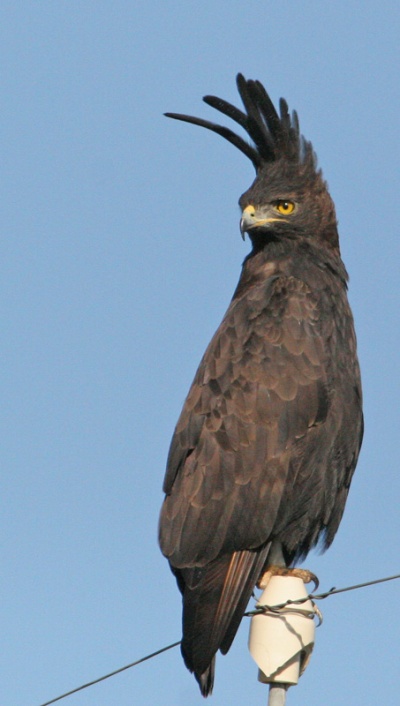- Lophaetus occipitalis
Other Names
Spizaetus occipitalis
Identification
The adult Long-crested Eagle is overall very dark brown or black, except for white patches at the joint of the wing both above and below, white under-wing coverts spotted with black, a white base to the tail and greyish brown tarsi. The eyes golden to reddish brown, the cere and feet yellow. Immatures can be distinguished from the adult by the whiter tips of the neck feathers, the less prominent crest, and a generally more mottled appearance. The eyes are dark olive-brown, the feet and cere pale ochre-yellow.
Distribution
Sub-Saharan Africa: widespread from Senegal east to Ethiopia and south to Angola and the Cape. Absent from the most arid areas of the Horn of Africa and the south-west. Resident and in some areas, nomadic.
Taxonomy
Habitat
Woodland, forest edge and plantations, cultivated areas with trees and swampy grasslands, from sea-level up to 3,000m
Behaviour
The diet of Long-crested Eagle consists mostly of small mammals caught on the ground, but also includes lizards, small snakes, orthoptera, etc. Very occasionally it takes young poultry, but is beneficial to man because of the number of small rodents that it kills.
Voice Whilst soaring in display there is a loud clear ringing 'keeee-eh' or 'keeee-ee-af'. There are also varied calls in the same tone 'kik-kik-kik-kik-keeee', etc. This is a noisy eagle, calling attention to its presence by frequent calling.
Status and behaviour in the wild This species is unmistakable in the field due to its all black appearance at rest and long black flopping crest, which is blown about by the wind. In flight the white patches on both sides of the wings are very noticeable. It is usually seen in flight, often calling, or perched on a tree or a telegraph pole. It does most of its hunting from such perches. It can be found wherever large trees and open country are mixed, and is one of the eagles that prefers cultivated country and areas of human habitation to uninhabited areas of bush. It spends much of the day perched and does soar as much as some other eagles. The pair are usually not far apart and have their regular areas in which they can be found day after day. During the heat of the day they often rest in a densely leafed tree. The range of a pair is not usually more than a mile or two either side of the nesting place in the breeding season, and the same bird will repeatedly use the same series of perches day after day.
Breeding It is quite noisy in display - soaring at a height of some 300-500 feet above its favoured haunts, calling repeatedly, but not seeming to perform any striking flight manoeuvres. It will also make display calls from perches, especially near the nest. The nest can be built at any height from twenty to sixty feet or more from the ground, in a large leafy tree such as a wild fig, or introduced Eucalyptus. It is often sited in a river valley where large trees may be available. When first built it is, for an eagle, a small structure - about two feet across by a foot deep - made of small sticks, and with a deep central cup about one foot across, lined with green leaves. It is usually in the centre of the nesting tree and well shaded, mostly in a fork of the trunk, but sometimes on a lateral limb. Both sexes take part in nest building and repair, and the same site is used for a number of years, but not generally for as long periods as with some other eagles. One or two eggs are laid, dull white rounded ovals, with cloudy markings of brown, grey, and lilac and sometimes with a few clear brown spots. The breeding usually takes place in the latter half of the dry season, and in some areas extends into wet periods. Only the female incubates, and she is fed near the nest by the male. She also leaves the nest to kill for herself at times. During the incubation period the male is often near the nest and roosts in the same tree or in another close by. In the early fledging period the female remains on or near the nest and the male brings prey to the site. After about three weeks the female brings more prey than the male. The young is fully feathered by about 28 days, and then grows steadily, climbing about on branches of the nest tree from 45 to 50 days and making its first flight at about 55 days. It then moves quickly away from the nest site. The parents continue to feed it for another two weeks or so after it has left the nest. The Long-crested Eagle usually breeds every year, and generally rears one young per nest, the second egg, when laid, being sometimes addled, or at other times the elder young one probably kills the other.




